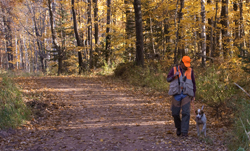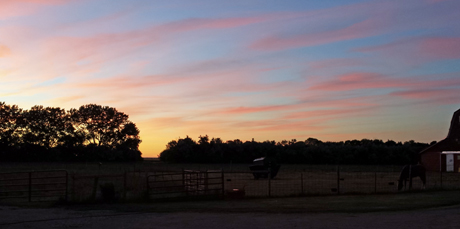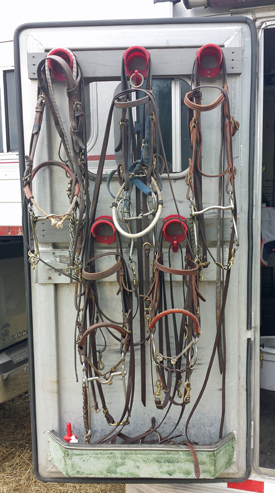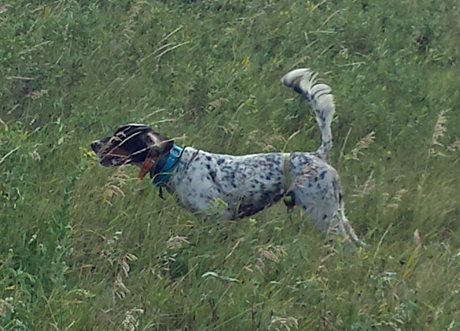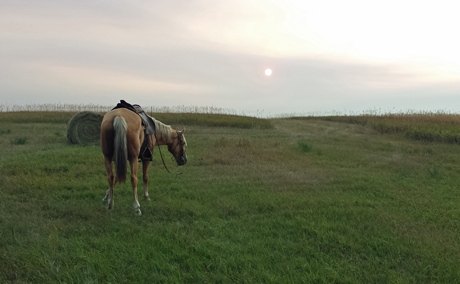Prairie 2013: training report
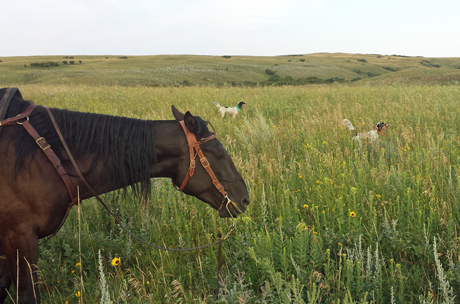
Houston’s Blackjack, left, and Northwoods Ahniwake Grace on point in a picturesque native prairie. Zack, Frank’s horse, ground ties and seems oblivious to the pending action.
Days start early at prairie training camp. Alarms ring at 4:30 to allow plenty of time for dark-roasted coffee and perhaps an English muffin or two. Outside, not a sound can be heard.
Within an hour, though, things start happening. Horse trailer doors squeak as they open and halters, bridles and bits are readied. Horses whinny as they’re gathered from the corral and loaded. Dogs are awake now, too. They lazily uncurl, stretch, shake and then begin barking in anticipation.
By 6:30, the sun has risen above the horizon and the first brace of dogs is turned loose.
Jerry and Frank LaNasa, his friend and partner in this prairie training camp since 1998, have spent the better part of August driving to southeastern North Dakota. Previously, each had traveled to the prairie to train their strings of dogs, but to different destinations—Jerry to the Sheyenne National Grassland and Frank to the camp of professional trainer Randy Downs in the far western part of the state.
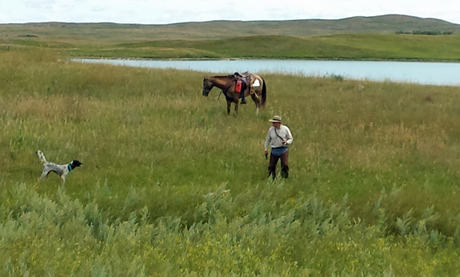
Frank’s setter Northwoods Nirvana displays his stunning posture when pointing a brood of young pheasants.
Sometime in the mid 1990s, the pair decided they wanted their own place and a more permanent situation. They did their research and scouted out likely areas. Then they discovered a unique area that borders the Coteau des Prairie, a plateau 200 miles long and 100 miles wide. It rises above the prairie flatland and is punctuated by beautiful, glacial lakes. The farms were few but vast and landowners were warm and welcoming. They found a place to rent that had a nice horse barn and room for lots of dogs and thus began their now 15-year tradition.
Changes—all on a vast, and perhaps, irreversible scale—have hit North Dakota since Jerry and Frank began their camp.
• Taking advantage of the steady winds on the high Coteau des Prairie, wind farms were constructed on about 14,000 acres of land. Each turbine is 262 feet tall and has blades that are 122 feet long.
• The discovery of oil in the Bakken Formation shale to the west and north has affected the entire state.
• Changes in the federal farm bill allowed more than 1,000,000 acres of CRP land to be planted to commodity crops like soybeans and corn. All those fields of alfalfa and prairie plants are now gone.
Jerry and Frank are well suited as training partners. They have similar work ethics and are extremely knowledgeable, whether discussing field trials, training methods, bird dog history or bird dog health. Both have remarkable memories, too. Not only can they rattle off pedigrees of dogs here and long passed but they seemingly remember every placement of every field trial.
It just might be the highlight of the year for both. Even though Frank is a serious competitor in horseback shooting dog and all-age field trials and Jerry is a professional dog trainer, the fun and gratification for both springs from this basic training and exposure to wild birds. Frank uses this time on the prairie to get his dogs in peak condition and readiness for fall field trials. Jerry focuses on steadiness training, handling and young dog development.
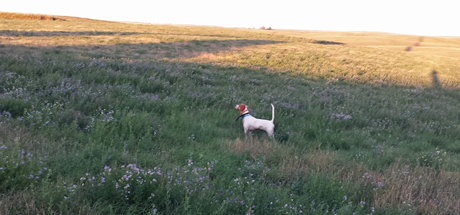
Among the long shadows of a prairie sunset, pointer Northwoods Vixen is high and tight in a field of alfalfa.
Frank is a St. Paul guy, born and raised, and graduated from St. Thomas University in St. Paul, where he was the starting star quarterback for three years. Frank and his wife, Jean, own Frank LaNasa Insurance, an independent agency that offers both commercial and personal coverage.
Jean is not only a partner in business but she’s an expert horsewoman and usually travels with Frank to field trials. She knows dogs, too, and acts as Frank’s scout.
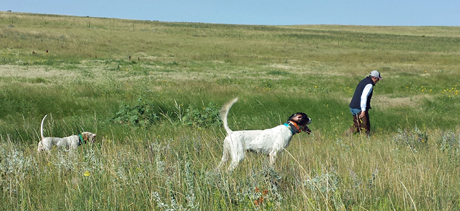
Frank flushes for a divided find by pointer True Confidence, on left, and setter Northwoods Grits. The dogs had a nice sharp-tail covey.
Frank is generally known for his pointers but lately he bought, and has been winning with, two very nice setters—Houston’s Blackjack and Northwoods Nirvana. His string of winning dogs is impressive.
• 4X CH Chief’s Prospector
• CH Creole Storm
• 2X CH/RU-CH Trouble My Friend
• 3X CH/RU-CH Isanti Blacktop
• RU-CH Dancing Queen
• 5X CH/RU-CH Front N’ Center
• 6X CH/2X RU-CH Centerpiece
• 2X CH Homemade
• CH Lil’ Miss Sunshine
• 2X RU-CH True Confidence
• CH Houston’s Blackjack
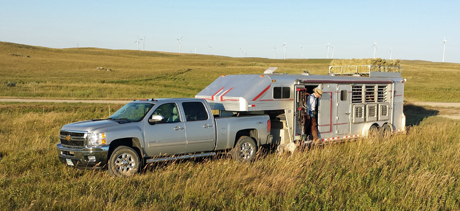
Training on the North Dakota prairie isn’t a simple operation. A heavy-duty diesel truck is necessary to pull a fifth-wheel horse trailer that has room for horses, dogs and gear. The rig is parked just off a gravel road where a section of the Tatanka Wind Farm is visible on the high Coteau des Prairie.




